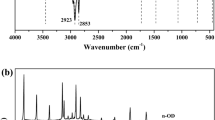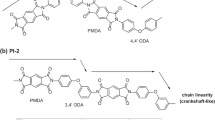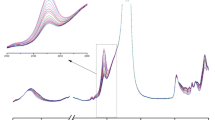Abstract
Polyurethane (PU) has become one of the most important segmented copolymers, due to it can be tailored to suit a wide range of application requirements by changing their structures and compositions. Amide, urethane and urea, which are capable of forming intermolecular hydrogen bonding to enhance the microphase separated morphology, are now used to consist segmented copolymers (poly(urethane-urea-amide) PUUA). In order to understand the usage temperature of the material and the protective measures which can be used, we wanted study the thermal stability and degradation process of PUUA. For study the stability of molecule structure, the thermal degradation behaviors of PUUA were extensively investigated with the thermogravimetric analysis (TG) under pure nitrogen and air, firstly. And the degradation activation energy of PUUA was further determined by the Flynn-Wall-Ozawa method. To find the order of thermal stability of bonds, thermogravimeter coupled with FTIR spectrophotometer (TG/FTIR) was used to research their gaseous products and their releasing intensity under nitrogen. In addition, the thermal decomposition behaviors of PUUA under air were also simulated by TG/FTIR. All results demonstrated that the bond of polyurethane decomposed firstly, both under air and nitrogen. And the protection of the bond of polyurethane was beneficial to prolong the service life of PUUA materials.












Similar content being viewed by others
References
Beniah G, Uno BE, Tian L et al (2017) Tuning nanophase separation behavior in segmented polyhydroxyurethane via judicious choice of soft segment[J]. Polymer 110:218–227
Bondar VI, Freeman BD, Pinnau I (2015) Gas sorption and characterization of poly(ether-b-amide) segmented block copolymers[J]. Journal of Polymer Science Part B Polymer Physics 37(17):2463–2475
Lee HS, Roy A, Badami AS, McGrath JE (2007) Synthesis and characterization of sulfonated poly(arylene ether) polyimide multiblock copolymers for proton exchange membranes[J]. Macromol Res 15(2):160–166
Miller JA, Lin SB, Hwang KKS, Wu KS, Gibson PE, Cooper SL (1985) Properties of polyether-polyurethane block copolymers: effects of hard segment length distribution[J]. Macromolecules 18(1):32–44
Mokeev MV, Zuev VV (2015) Rigid phase domain sizes determination for poly(urethane–urea)s by solid-state NMR spectroscopy. Correlation with mechanical properties[J]. Eur Polym J 71:372–379
Mihajlovic M, Staropoli M, Appavou MS, Wyss HM, Pyckhout-Hintzen W, Sijbesma RP (2017) Tough supramolecular hydrogel based on strong hydrophobic interactions in a multiblock segmented copolymer[J]. Macromolecules 50:3333–3346
Schreiner C, Bridge AT, Hunley MT, Long TE, Green MD (2017) Segmented imidazolium ionenes: solution rheology, thermomechanical properties, and electrospinning[J]. Polymer 114:257–265
Luong ND, Le HS, Minna M et al (2016) Synthesis and characterization of castor oil-segmented thermoplastic polyurethane with controlled mechanical properties[J]. Eur Polym J 81:129–137
Mizgajski A, Bródka S, Fagiewicz K et al (2010) Natural conditions as a premise for the development of the Poznań urbanised area[J]. Int J Therm Sci 98:156–164
Chung YC, Han A, Lee GS et al (2016) The effects of grafting bisphenol a or naphthalene derivative onto polyurethane with respect to shape memory and thermal properties[J]. Macromol Res 24(1):1–4
Sheth JP, Klinedinst DB, Wilkes GL, Yilgor I, Yilgor E (2005) Role of chain symmetry and hydrogen bonding in segmented copolymers with monodisperse hard segments[J]. Polymer 46(18):7317–7322
Chattopadhyay DK, Raju KVSN (2007) Structural engineering of polyurethane coatings for high performance applications ☆[J]. Prog Polym Sci 32(3):352–418
Kim H, Miura Y, Macosko CW (2010) Graphene/polyurethane nanocomposites for improved gas barrier and electrical conductivity[J]. Chem Mater 22(11):3441–3450
Chen JH, Hu DD, Li YD, Meng F, Zhu J, Zeng JB (2018) Castor oil derived poly(urethane urea) networks with reprocessibility and enhanced mechanical properties[J]. Polymer 143:79–86
Reis RA, Pereira JHC, Campos ACC, Barboza EM, Delpech MC, Cesar DV, Dahmouche K, Bandeira CF (2018) Waterborne poly(urethane-urea) gas permeation membranes for CO2/CH4 separation[J]. J Appl Polym Sci 135(11)
Buckwalter DJ, Dennis JM, Long TE (2015) Amide-containing segmented copolymers[J]. Prog Polym Sci 45:1–22
Sheth JP, Xu J, Wilkes GL (2003) Solid state structure–property behavior of semicrystalline poly(ether- block -amide) PEBAX ®;, thermoplastic elastomers[J]. Polymer 44(3):743–756
Krijgsman J, Husken D, Gaymans RJ (2003) Synthesis and properties of thermoplastic elastomers based on PTMO and tetra-amide[J]. Polymer 44(25):7573–7588
Kayalvizhi M, Suresh J, Karthik S, Arun A (2016) Synthesis and characterization of MDI and functionalized polystyrene based poly(urethane-urea-amide)[J]. Int J Plast Technol 20(1):128–142
Kong W, Yang Y, Liu Z, Jiang L, Zhou C, Lei J (2017) Structure–property relations of nylon-6 and polytetramethylene glycol based multiblock copolymers with microphase separation prepared through reactive processing[J]. Polym Int 66:436–442
Kissinger HE (1956) Variation of peak temperature with heating rate in differential thermal analysis[J]. J Res Natl Bur Stand 57(4):217–221
Yao F, Wu Q, Lei Y, Guo W, Xu Y (2008) Thermal decomposition kinetics of natural fibers: activation energy with dynamic thermogravimetric analysis[J]. Polym Degrad Stab 93(1):90–98
Goyenola C, Stafström S, Hultman L et al (2016) Structural patterns arising during synthetic growth of fullerene-like Sulfocarbide[J]. J Phys Chem C 116(39):21124
Sang MS, Kim SH, Song JK (2009) Thermal decomposition behavior and durability evaluation of thermotropic liquid crystalline polymers[J]. Macromol Res 17(3):149–155
Ma Z, Sun Q, Ye J, Yao Q, Zhao C (2016) Study on the thermal degradation behaviors and kinetics of alkali lignin for production of phenolic-rich bio-oil using TGA–FTIR and Py–GC/MS[J]. J Anal Appl Pyrolysis 117:116–124
Acknowledgements
We would like to thank the generous supports by the Experiment center of Polymer science and engineering academy, Sichuan University, Chengdu, China. We also acknowledge Ms. Rong Zhang of Sichuan University, who helps us analyses the results of TG/FTIR.
Author information
Authors and Affiliations
Corresponding author
Rights and permissions
About this article
Cite this article
Yang, Y., Cao, X., Luo, H. et al. Thermal stability and decomposition behaviors of segmented copolymer poly(urethane-urea-amide). J Polym Res 25, 242 (2018). https://doi.org/10.1007/s10965-018-1634-z
Received:
Accepted:
Published:
DOI: https://doi.org/10.1007/s10965-018-1634-z




